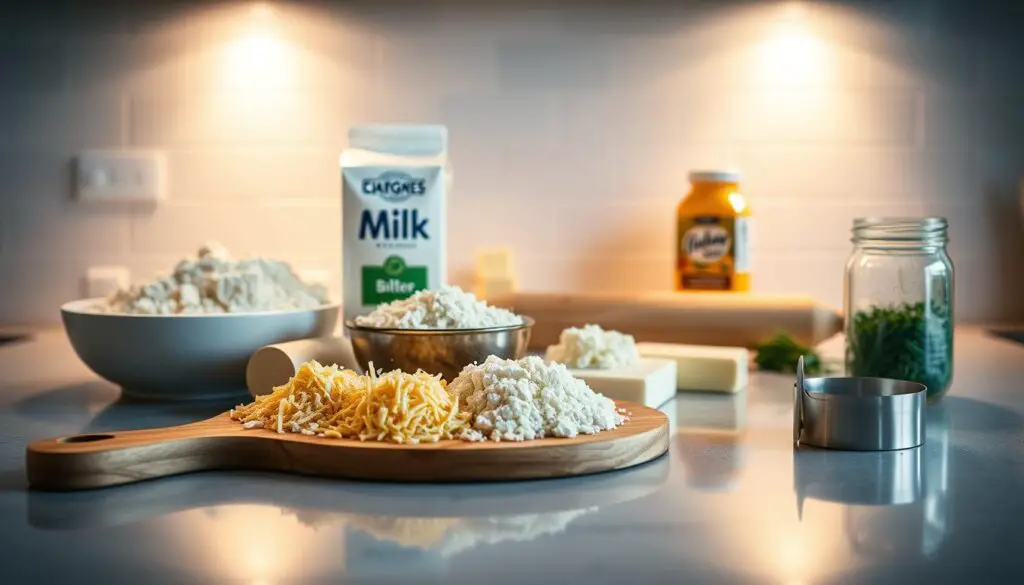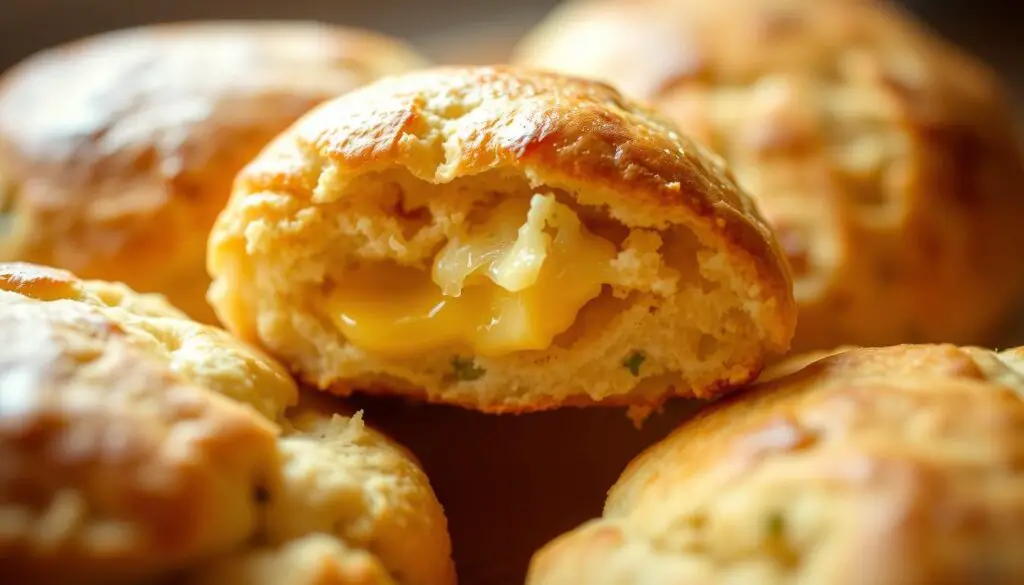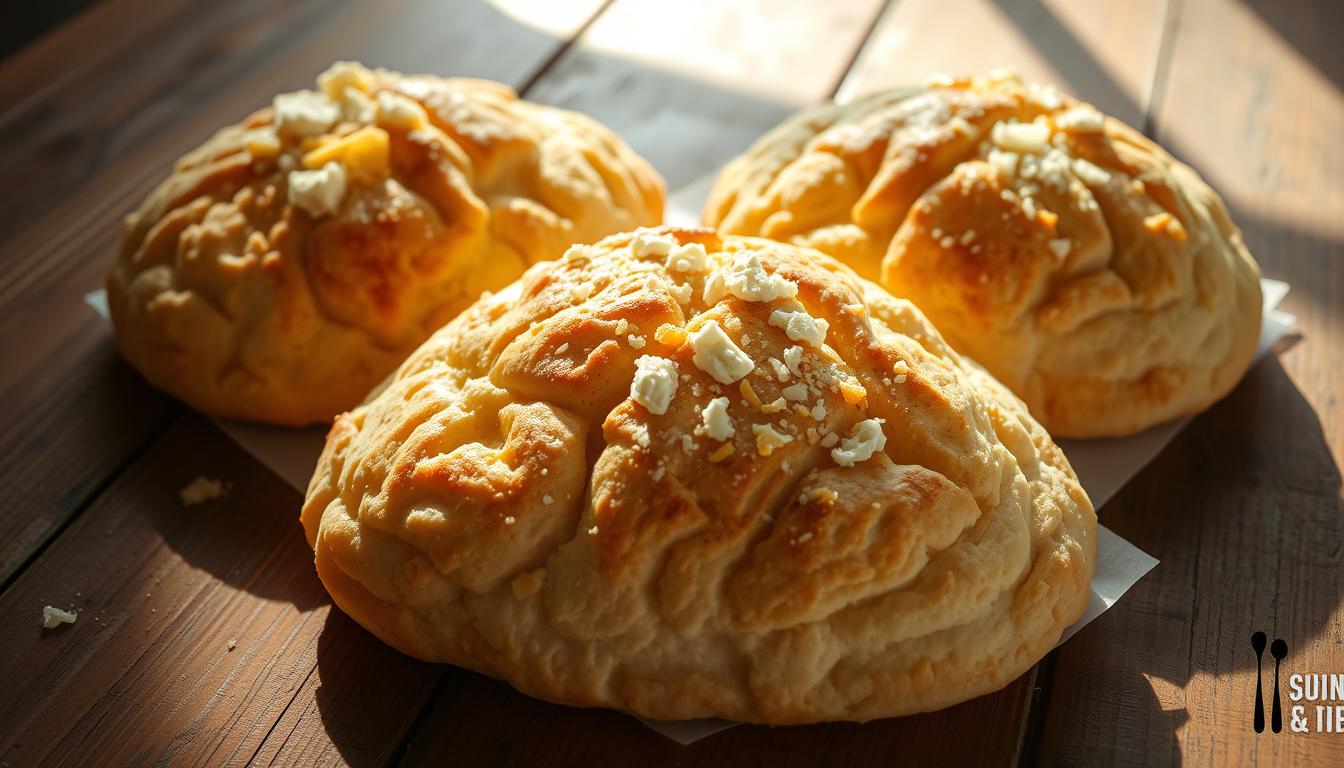There's something special about biting into a warm, flaky cheese scone straight from the oven. The combination of tender, fluffy interior and the golden, cheesy crust is irresistible. For me, it's a memory tied to lazy Sunday mornings and cozy afternoons with family.
My journey to perfecting the ultimate cheese scones recipe has been years in the making. I've experimented with various cheeses and techniques to create a recipe that yields scones that are not only delicious but also easy to make.
These savory scones are a game-changer for breakfast, lunch, or as a complement to your favorite soups and salads. With a mix of robust and milder cheeses, they offer a depth of flavor that's hard to resist.
Key Takeaways
- Learn how to make perfectly flaky and tender cheese scones every time.
- Discover the secret to combining three distinct cheeses for maximum flavor.
- Get a step-by-step guide to preparing and baking these delicious scones.
- Understand the importance of selecting the right cheeses for the best flavor.
- Find out how to serve these versatile scones for various meals.
The Perfect Three Cheese Scones
With a blend of three distinct cheeses, these scones offer a flavor experience that's hard to beat. My passion for these cheese scones stems from their versatility and the way they combine flavors in one delicious package.
Why I Love This Recipe
This recipe creates scones with the perfect balance of flakiness and tenderness, avoiding common pitfalls like dry or dense texture. The combination of cheddar, parmesan, and a softer cheese like feta creates layers of flavor that make these cheese scones truly special.
I've tested countless recipes over the years and refined this one to ensure consistent results. The end product is a batch of scones that are not only delicious but also visually appealing.
The Secret to Flaky Cheese Scones
The secret to perfectly flaky scones lies in handling the butter and dough throughout preparation. Cold butter is essential as it creates steam pockets during baking, resulting in flaky layers.
Working the dough minimally prevents gluten development, making your scones tender rather than tough. These details make all the difference between ordinary and extraordinary cheese scones.
Ingredients You'll Need
To make the perfect Three Cheese Scones, you'll need a selection of high-quality ingredients. The quality of your ingredients directly impacts the flavor and texture of your scones.
The Three Cheeses
The star ingredients in these scones are the three cheeses, each serving a specific purpose. I recommend using a mature cheddar for its robust flavor, parmesan for a savory depth, and a softer cheese like feta or cream cheese for moisture and richness. The combination of these cheeses creates a complex and satisfying flavor profile.
Dry Ingredients
For the dry ingredients, you'll need all-purpose flour as the base, baking powder to help the scones rise, and salt to enhance the flavors. The flour provides structure, while the baking powder ensures the scones bake properly.
Wet Ingredients
The wet ingredients include cold, cubed butter and buttermilk. The cold butter is crucial for creating a flaky texture, while the buttermilk adds tanginess and tenderness. If you don't have buttermilk, you can substitute it with regular milk and a splash of lemon juice or vinegar.
| Ingredient | Quantity |
|---|---|
| All-purpose flour | 345g (2 ¾ cups) |
| Baking powder | 1 tablespoon |
| Salt | 1 teaspoon |
| Unsalted butter, cold and cubed | 113g (½ cup) |
| Grated cheese | 200g (7oz) |
| Fresh chives, finely chopped | 2 tablespoons |
| Buttermilk | 225g (8oz) |

My Step-by-Step Baking Method
To achieve flaky and delicious cheese scones, follow my step-by-step baking method. This guide will walk you through the process of preparing the dough, applying the lamination technique, and baking your scones to perfection.
Preparing the Dough
The first step in making three cheese scones is preparing the dough. Start by whisking together flour, salt, and baking powder in a large bowl. This ensures that the leavening agents are evenly distributed throughout the dough.
Next, chop the cold butter into cubes and add it to the dry ingredients. Use a pastry cutter or your fingertips to work the butter into the flour until you achieve pea-sized crumbs. It's crucial not to overwork the butter, as this will create steam pockets during baking, resulting in flaky layers.
After incorporating the butter, stir in the grated cheese and chopped chives. Make a well in the center of the flour mixture and pour in the buttermilk. Use a rubber spatula or wooden spoon to gently fold the mixture until it forms a shaggy dough. If the dough is too dry, add a little milk. The dough should be soft and slightly sticky but not wet.
The Lamination Technique
The lamination technique is what sets my recipe apart. It involves folding the dough like a letter to create distinct layers. Place the dough onto a lightly floured surface and push it into a ball. Use a rolling pin to roll it out into a rectangle of about 7×10 inches.
Lift the top third of the dough and bring it into the middle, then fold the bottom third over it. Turn the dough 90° and repeat the rolling and folding process twice more. This technique creates the flaky layers that make cheese scones so delicious.

Baking Your Cheese Scones
After the final fold, roll the dough to about 1-inch thickness and use a sharp knife to cut it into squares or traditional shapes. Place the cut scones on a tray lined with parchment paper, leaving space between each for expansion during baking.
Brush the tops of the scones with milk and sprinkle with additional grated cheese. Bake in a preheated oven at 425°F/220°C for about 15-18 minutes, or until the scones are golden brown and well-risen.
| Baking Stage | Temperature | Time |
|---|---|---|
| Preheating | 425°F/220°C | – |
| Baking | 425°F/220°C | 15-18 minutes |
By following these steps and maintaining cold ingredients and minimal handling, you'll achieve the perfect texture for your scones. Enjoy your delicious homemade three cheese scones!
Serving and Storing Your Three Cheese Scones
As you pull apart a freshly baked scone, the melted cheese and butter melding together is a culinary delight. To fully enjoy your Three Cheese Scones, it's best to serve them warm, straight from the oven. You can enhance this experience by pairing them with a pat of butter or a slice of cheese and chutney for a delightful afternoon tea.
Serving Suggestions: These scones are also a great accompaniment to a bowl of soup or stew. For a more substantial meal, consider splitting and filling them with ingredients like ham, scrambled eggs, or avocado. To preserve their fluffy texture, gently pull the scones apart with your hands instead of cutting them with a knife.
Storage Tips: If you have leftover scones, you can store them in an airtight container at room temperature for up to 4 days. For longer storage, freeze the scones on a baking tray lined with parchment paper until solid, then transfer them to a freezer bag. Frozen scones can be reheated in the microwave or a preheated oven at 350°F (175°C) for about 10 minutes.
- Reheat frozen scones in the microwave or oven for a quick snack.
- Experiment with adding herbs or spices to the dough for different flavor variations.
- The versatility of this recipe allows for substitutions, such as different types of flour, though the texture may vary slightly.
FAQ
What type of flour is best for making cheese scones?
I recommend using all-purpose flour with a moderate protein level to create a tender and flaky texture in your scones. When I make my scones, I use a high-quality all-purpose flour that contains a blend of hard and soft wheat flours.
Can I use other types of cheddar in my recipe?
Yes, you can experiment with different types of cheddar, such as sharp or extra-sharp, to give your scones a unique flavor profile. I often use a combination of sharp and mild cheddar for a balanced taste.
How do I prevent my scones from becoming too dense?
To avoid dense scones, make sure to not overmix the dough and keep your ingredients, especially the butter, cold. This will help to create a flaky texture and prevent the scones from becoming tough.
What is the ideal baking time and temperature for cheese scones?
I bake my scones in a preheated oven at 400°F (200°C) for about 15-20 minutes, or until they're golden brown. Keep an eye on them to ensure they don't overcook.
Can I prepare the dough ahead of time?
Yes, you can prepare the dough in advance and store it in the refrigerator for up to a day or freeze it for later use. Just be sure to let the dough come to room temperature before baking.
How do I store leftover scones?
To keep your scones fresh, store them in an airtight container at room temperature for up to 2 days or freeze them for up to 2 months. Simply thaw and reheat in the oven or microwave when you're ready to enjoy them.



